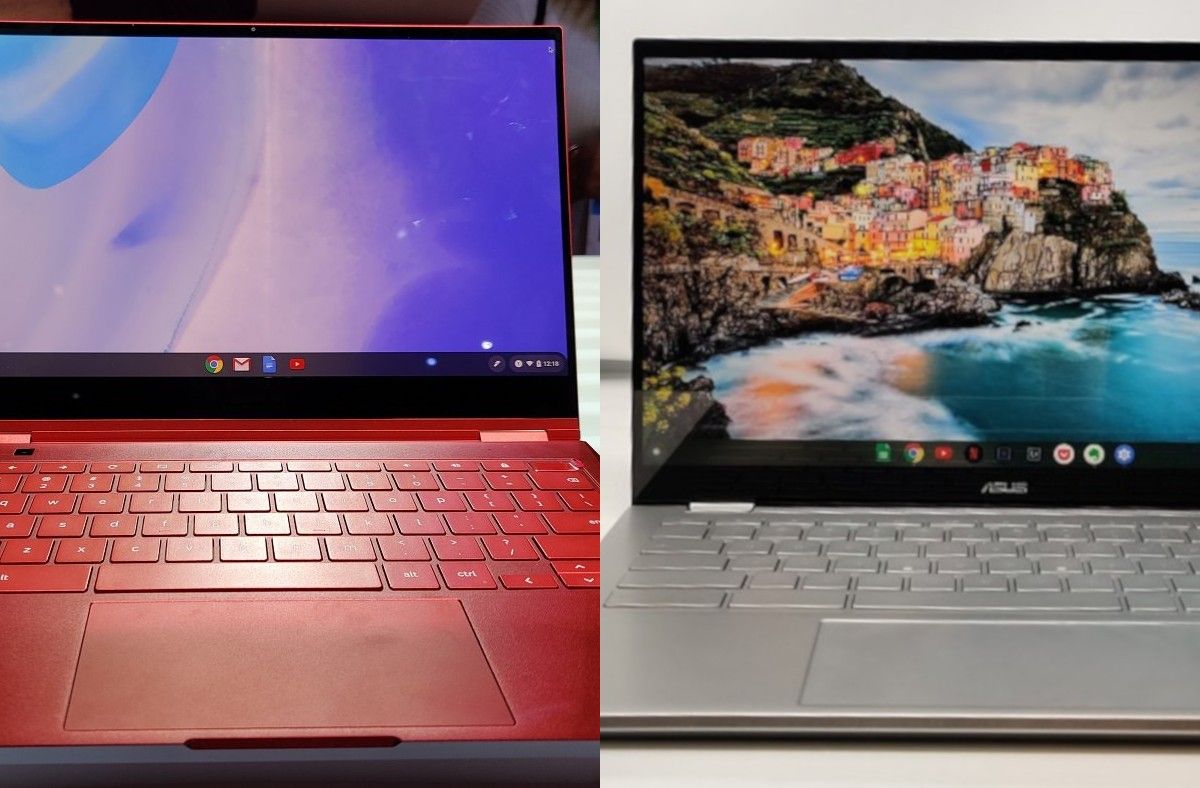While smartphones tend to get a lot of attention at CES, the show typically has many, many more laptops. This year, we saw a couple of high-end Chrome OS laptops from ASUS and Samsung at the show. These two manufacturers have built some of the best Chromebooks over the last few years. The ASUS Chromebook Flip C436 and Samsung Galaxy Chromebook look to continue that. Both laptops have been included in Intel's expanded Project Athena program as well, which is for thin, light laptops with high-end Intel processors and specs.
ASUS Chromebook Flip C436
The Chromebook Flip C436 is a follow-up to the Flip C434 from last year. It's not a huge upgrade year-over-year, but it continues ASUS' line of excellent Chrome OS devices. As the name implies, this is another Chromebook with a display that can flip around to be used as a tablet.
|
Chromebook Flip C436 |
|
|---|---|
|
CPU |
Intel® Core™ i7-10510U ProcessorIntel® Core™ i5-10210U ProcessorIntel® Core™ i3-10110U Processor |
|
Display |
14-inch four-sided NanoEdge display with only 4.9mm slim bezel and 85% screen-to-body ratio |
|
OS |
Chrome OS |
|
Graphics |
Intel® UHD Graphics |
|
Main memory |
LPDDR3 8GB/ 16GB (2133MHz) |
|
Storage |
128GB/ 256GB/ 512GB PCIe Gen3 x2 NVMe M.2 SSD |
|
Wireless |
Dual band Wi-Fi 6 (802.11ax)Bluetooth® 5.0 |
|
I/O |
2 x USB 3.2 Gen 1 Type-C (Full function)1 x micro SD card (up to 2TB extension)1 x audio jack COMBO |
|
Battery |
42WHr battery Li-Polymer, 3 cell |
|
Dimensions |
319.54 x 205.3 x 13.76 mm |
|
Weight |
1.1kg |
This year, the Flip C436 features a slightly thinner and lighter magnesium alloy body, which ASUS says is the thinnest and lightest 14-inch Chromebook. The 14-inch display is a 1080p touchscreen with 16:9 aspect ratio. Under the hood, the laptop is powered by Intel's 10th Gen processors and you can go up to the Core i7 with 16GB of RAM and 512GB SSD in the top model.
The thinness is really the striking feature of this laptop. When you turn it to the side you can really get a feel for how thin this thing is. Coming in at just 2.4 pounds and 13.7mm in thickness, the Chromebook Flip C436 is a great option for a light and fast backpack laptop. ASUS did not announce pricing at CES, but we expect the low models to start around $600.
Samsung Galaxy Chromebook
The Samsung Galaxy Chromebook is a similar story to the Chromebook Flip C436. This is a very thin and lightweight Chromebook with Intel's 10th Gen processors. The Galaxy Chromebook falls in Samsung's series of Galaxy Book laptops, most of which are powered by Windows 10. The Galaxy Chromebook has a lot in common with premium Windows laptops.
|
Galaxy Chromebook |
||
|---|---|---|
|
Dimensions |
302.6 x 203.2 x 9.9mm |
|
|
Weight |
1.04kg |
|
|
OS |
Chrome OS |
|
|
Display |
13.3” 4K AMOLED Display (3840×2160), Touch Screen |
|
|
CPU |
Intel® 10th generation Core™ Processor |
|
|
Graphics |
Intel® UHD Graphics |
|
|
Memory |
Up to 16GB (LPDDR3) |
|
|
Storage |
Up to 1TB SSD |
|
|
WLAN |
Wi-Fi 6 (Gig+), 802.11 ax 2×2 |
|
|
Camera / Mic |
1MP (Front), 8MP (on Keyboard deck)Internal Digital Dual Array Mic + Mono Mic |
|
|
Audio |
Stereo Speakers (2W x 2) |
|
|
Pen |
Built-In Pen |
|
|
Security |
Fingerprint |
|
|
Keyboard |
Backlit |
|
|
Material |
Aluminum |
|
|
Ports |
USB-C (2) | 3.5pi HP/Mic | UFS/MicroSD Combo |
|
|
Battery |
49.2Wh (Typical) |
|
The headlining feature of the Galaxy Chromebook is the display. Samsung has equipped this Chromebook with a 13.3-inch 4K AMOLED display, which is undoubtedly one of the best you can get on a Chrome OS device. The display is a touchscreen and it can be flipped all the way around. That display is housed in a very thin 9.9mm body that also includes a stylus. The stylus is much longer than a Galaxy Note S Pen and it can slide into the body, which is always a huge plus.
In terms of performance, the Galaxy Chromebook has the 10th Gen Intel Core i5 processor, up to 16GB of LPDDR3 RAM, and up to 1 TB of SSD storage. Also, if you're interested in flashy colors, the Galaxy Chromebook is available in a bright red (as shown in the video and photos). All of these high-end specs come at a price of $999.
These two Chromebooks have a lot in common as they are both pushing the "premium Chrome OS' segment. The Samsung Galaxy Chromebook has the obvious edge in terms of display quality, but ASUS has put together a very solid package for a more affordable price. If you need a Chrome OS device, it's hard not consider both of these laptops.
The real question is do premium Chrome OS devices have a place in the laptop market. Do you need to spend $1,000 on a Chromebook when you can get a Chrome OS laptop that performs perfectly well for half the price? High-end specifications are more important on a Windows device as it can do more intensive tasks. Do you think it's important to have these premium features in a Chromebook?

